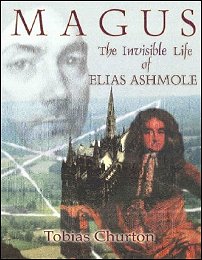Tobias Churton: Magus: The Invisible
Life of Elias Ashmole
(Lichfield, UK, Signal Publishing, 2004). ISBN 0-9543309-2-7.

Reviewed by Christopher McIntosh
Bremen, Germany
Admirers of Tobias Churton’s previous books, such as The Gnostics, The Golden Builders and The Gnostic Philosophy, will not be disappointed by his new biography of one of the most remarkable men England has ever produced: Elias Ashmole, founder member of the Royal Society, Windsor Herald, Astrologer to the King, Alchemist, Hermeticist, early Freemason, founder of the Ashmolean Museum in Oxford and a “mighty good man”, as his contemporary the antiquarian John Aubrey called him.
Surprisingly this towering figure has had relatively few books devoted to him, the main previous one being C.H. Josten’s massive edition of Ashmole’s writings, published in five volumes by Oxford University Press in 1966, which Churton builds on and acknowledges as “the masterpiece of Ashmole studies”. Perhaps this scarcity of biographies is due to the difficulties of encompassing such a many-faceted figure, “a Renaissance man”, as Churton puts it, “in an era that was slip-sliding away from the limitless ambition of the Renaissance philosophy of human dignity”. Another reason may be a tendency in certain circles to denigrate Ashmole’s contribution to learning. “Ashmole ‘gets in the way’ of a neat classification of eras of knowledge. He is a Renaissance magus-type yet still a rational mathematician and founder member of the Royal Society. He is historically ‘inconvenient’.”
It is clear from these quotes that the author passionately admires Ashmole and the world view that he represents. Churton also has certain things in common with his subject. Both went to Brasenose College, Oxford, and both grew up in Lichfield in Staffordshire – Ashmole was a generous patron of Lichfield’s great cathedral and managed to save part of its library from destruction by Cromwellian vandals during the Civil War. Churton believes that Ashmole has much to teach the present age, which he clearly regards as a decadent one and frequently says so in his eloquent, sometimes abrasive and often witty manner.
“Ashmole would have borne an informed contempt for the ‘modern’ or its twisted offspring, the ‘post-modern’. Rather, we are all part of a living tree whose roots feed us vital sap from the past. That a thing was past did not mean that it ceased to be; rather the present and the future were utterly contingent upon the life that flowed through all time. The folly of man was to forget the reality that all that has been is. ‘It’ is in our eyes, our ears, our homes, our dreams, our aspirations, our blood. The memory required jerking from time to time – that was a task for the antiquarian. Nothing is dead unless it has been killed.”
Readers who find Churton’s particular style refreshing, as I do, will also appreciate the unusual format and presentation of the book. The pages are unusually large for a book of this kind (27 by 21cm) with wide margins to accommodate the many black-and-white photographs and illustrations. As the author explains:
“This is a photo-biography of a type that I hope may become more common in the future. Many a biography suffers from very limited illustrative possibilities, often a result of publishing cots. Modern technology enables a more exciting marriage of text and image. If every picture tells a story, then the reader has the opportunity to enjoy double the value of the research and share in a portion of the author’s pleasure in following the trail of his subject: a process of visual archaeology.”
Churton traces Ashmole’s rise from saddler’s son in Lichfield to one England’s greatest luminaries in a way that brings him vividly to life and makes us share the author’s admiration for him. The book is written from a deep understanding of the Hermetic, alchemical, masonic and Rosicrucian traditions that are so important for a full understanding of Ashmole, who emerges as a seminal figure in many different areas. His alchemical magnum opus, the Theatrum Chemicum Britannicum, “would become Isaac Newton’s most heavily consulted alchemical text when he came to search for the single divine principle through a thorough working of alchemical experiments”. Churton also throws much light on Ashmole’s important role in the history of Freemasonry – he was one of the earliest recorded initiates into a lodge in a non-operative capacity (at Warrington, Lancashire in 1646). Then of course there is the achievement for which he is probably best known, namely his creation of the Ashmolean Museum, which was partly inspired, as Churton argues, by the notion of a repository of universal knowledge as described in the Rosicrucian writings and in Francis Bacon’s New Atlantis. As the inscription on Ashmole’s tomb in St. Mary’s church, Lambeth, says “so long as the Ashmolean Museum of Oxford endures he will never die”. With these words Tobias Churton concludes this valuable and thought-provoking study of Ashmole’s life.